Labelexpo Americas 2024 – Press technology
Flexo bounced back and new digital and hybrid presses were launched onto the North American market at Labelexpo Americas 2024.

Labelexpo Americas 2024 set new records for narrow-web UV inkjet speed and print resolution, saw an exhilarating display of mid-web flexographic potential and witnessed all-round progress towards integration of digital (and digitized) printing systems into Cloud-based factory networks.
Mark Andy appeared as a different company from the last Americas show. The stand was bursting with innovation, including the global launch of a new 26in-wide Performance press, the fastest UV inkjet press on the market, as well as new hybrid press configurations developed with longtime partner Domino.
Let’s start with the mid-web Performance Series S9, a press available in 17in as well as the 26in-wide version shown at Labelexpo Americas.
“Mark Andy customers are asking for a wider web for PS labels. And a lot of customers who want to get into flexible packaging, and this is the perfect width. It also makes a lot of sense for IML and wraparound labels”
‘The Performance S9 is the first time we’ve integrated sleeve technology and automation and proprietary drying technology in a Mark Andy press,’ says Duane Pekar, recently appointed CEO of Mark Andy. ‘There are a lot of cost pressures out there, so our customers are asking for a wider web for PS labels. Also, we have a lot of customers who want to get into flexible packaging, and this is the perfect width. It also makes a lot of sense for IML and wraparound labels.’
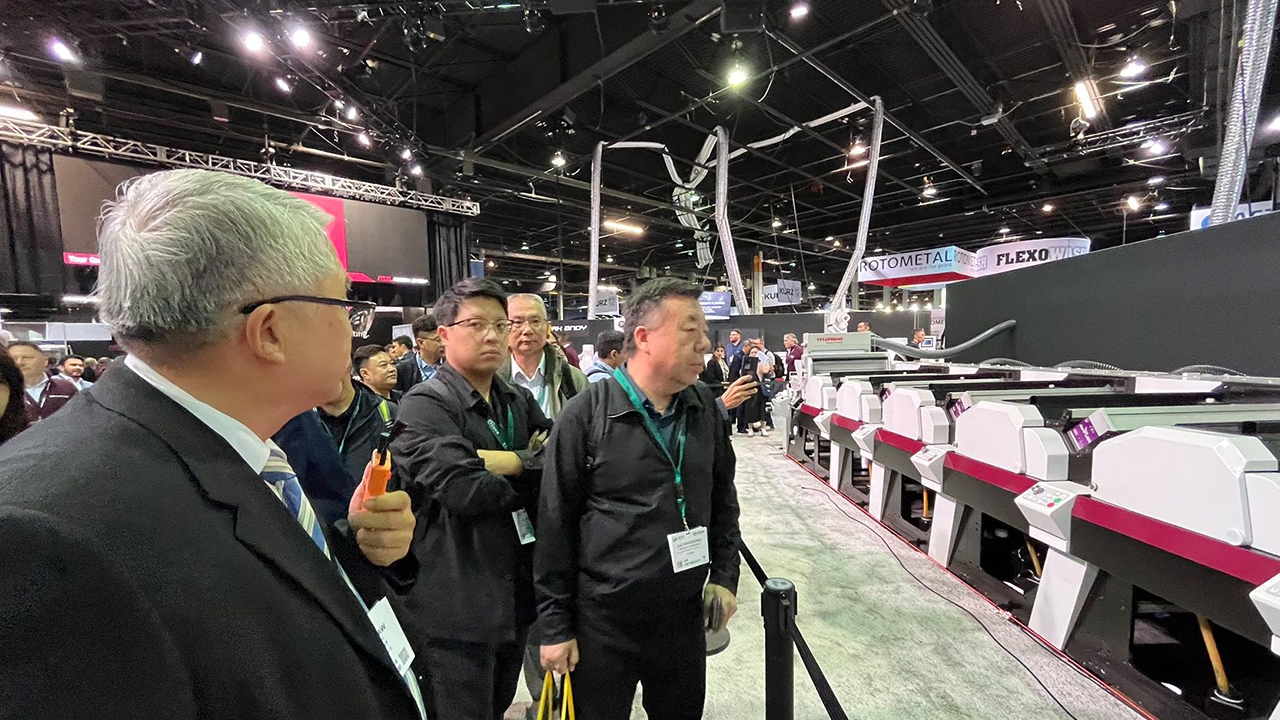
Next up, the Mark Andy Digital Series HD HighSpeed 1200 press launched at the show reached an unprecedented speed of 480ft/min (146m/min) – the fastest UV inkjet press on the market today, and printing at 1200 DPI resolution.
The press was developed by Mark Andy’s in-house digital team based in San Diego.
Mark Andy recently extended its partnership with Global Graphics to integrate the company’s SmartDFE digital front end into the Highspeed 1200. Printhead electronics are provided by Meteor Inkjet, another Hybrid Software company, with full integration into the SmartDFE.
Labelexpo Americas 2024 also highlighted Mark Andy’s developing partnership with Domino. An N610i Domino integration module was running on a shaft-drive Mark Andy 2200 press, demonstrating an upgrade path for the legion of legacy MA2200 presses installed worldwide. The N610i can also be retrofitted to Performance and Evolution presses.
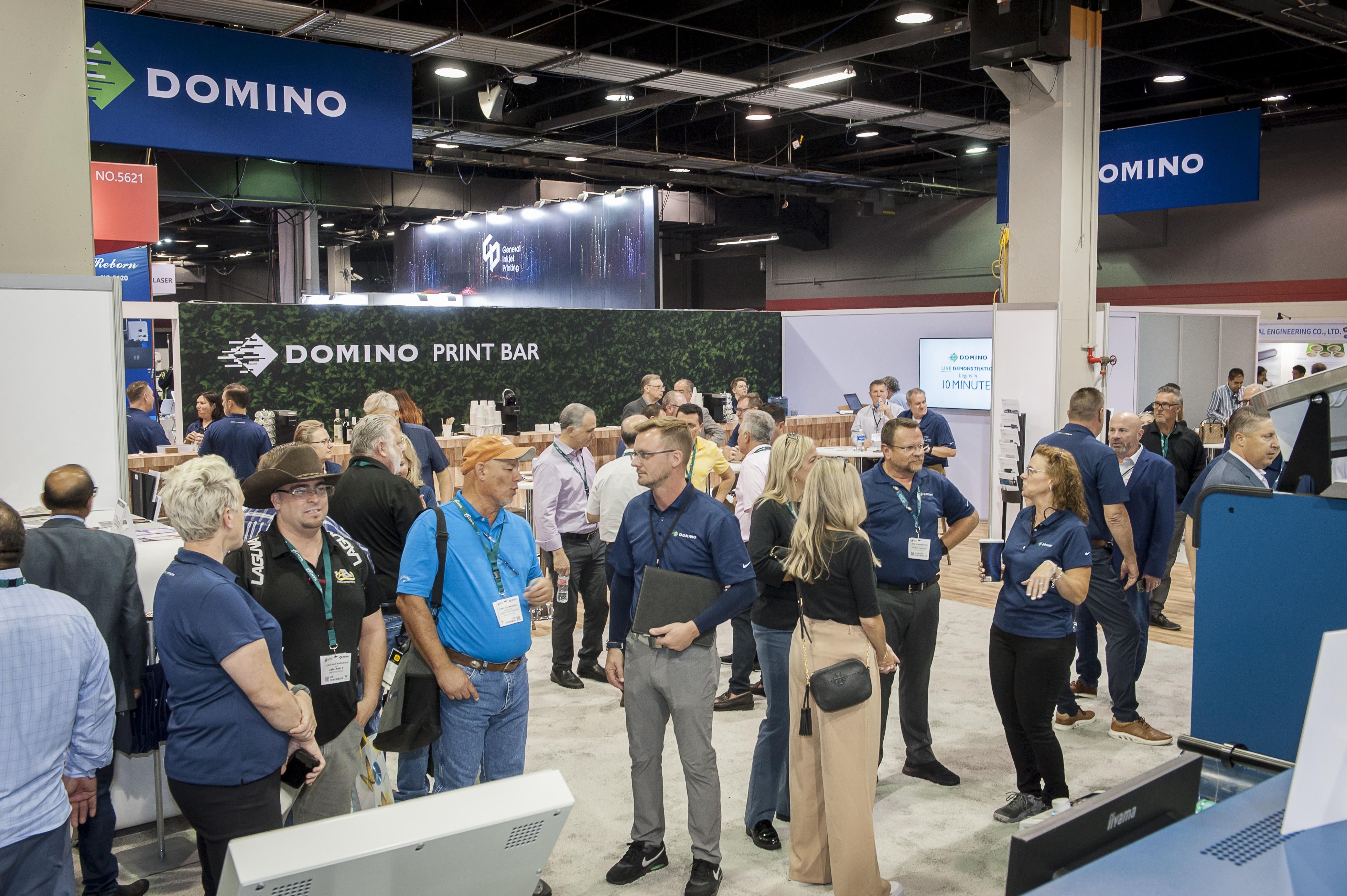
New at the show was the announcement that Domino’s latest 13in/330mm‑wide N710i press is now available as an integration module, using 1200x1200 DPI Bitstar inkjet heads developed by Brother, Domino’s Japan-based parent company. Mark Andy is currently working with Domino to develop a 17in-wide version.
At the entry level, Mark Andy demonstrated a standalone digital presses developed in partnership with Konica Minolta, most recently integrating the AccurioLabel 400 toner engine, which increases the speed over the AL230 and adds white to the CMYK toner engine.
The company further announced the Mark Andy 360 support service, which runs alongside the company’s growing supplies business.
The highlight of the Nilpeter stand was the first North American showing of the FA-26 mid-web press launched last year at Labelexpo Europe.
The 26in/670mm-wide FA-26 is designed for packaging formats that benefit from a wider web width – primarily flexible packaging, shrink sleeves and IML, as well as high-volume PS label and wraparound label production.
To handle extensible and heat-sensitive materials, the landscape print groups include large chill drums on each station and the press is fitted throughout with GEW’s LeoLED2 water-cooled LED-UV lamps. The press can be configured for reverse-side printing, and inline lamination can be added. Fast tool loading and substrate-specific job recall are key features.
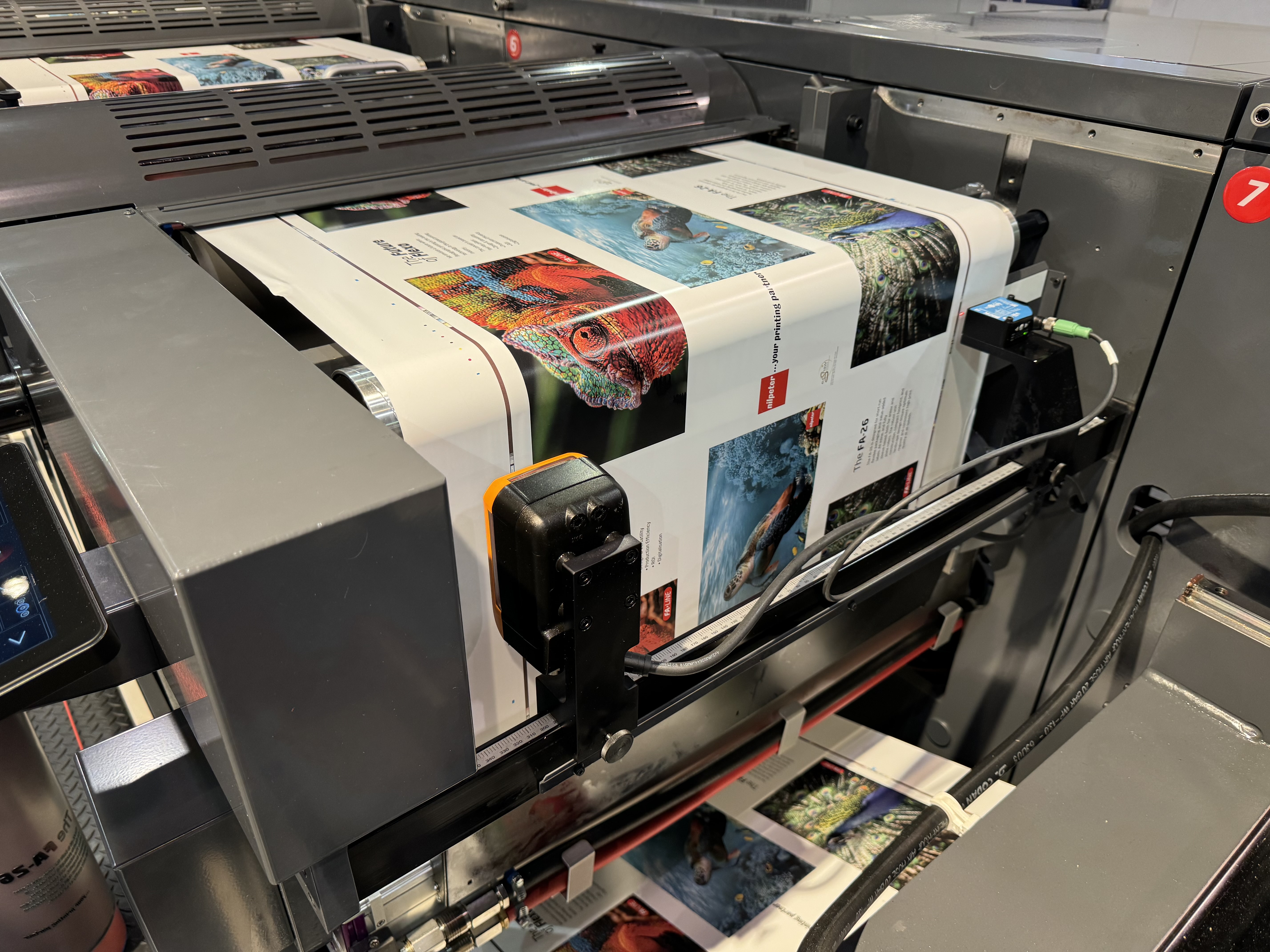
The FA-26 press was shown with Nilpeter’s new camera-based vision technology, developed in conjunction with B&R Industrial Automation, which maintains color registration when working with flexible and extensible materials.
Nilpeter demonstrated ramping the press speed up and down, and even deliberately putting the press out of registration, to demonstrate how effective the vision system is in automatically bringing the press back into register during both acceleration and deceleration, with automated dynamic adjustment of print pressure and web tension. The press was set up and run by a single operator.
“Press-wide mono digital print bars are proving a major area for development, adding enormous versatility to not just flexo presses, but to finishing/converting systems and even to laminators”
The camera reads color-on-color marks and compares them to a master mark, carrying out image processing in real-time and adjusting for any variation in print alignment.
The camera system will not currently work with clear materials, but Nilpeter is working to solve that issue. For these cases, the press uses the backup register mark sensor. The vision system is fully integrated with data collection capabilities for production monitoring.
The camera registration can also be retrofitted to all FA-line presses.
The show floor FA-26 also demonstrated Nilpeter’s Digital Shadow technology, which creates a real-time digital twin of the physical press. Its primary uses are to track, measure and optimize printing operations, and it is a powerful training tool.
The press was printing an Actega extended color gamut ink set, with a complete sleeve job change carried out in two minutes.
Bobst demonstrated the latest version of its Accucheck inline inspection and calibration system on a Digital Master 340 ‘All-in-One’ hybrid press.
New Accucheck features include an automated quality inspection setup for every job, synchronized to the job queue. A full printhead calibration checking for alignment and density across the web is achieved in just 15 minutes. Another improvement is the upgraded automatic nozzle compensation system, which now also accounts for deviated nozzles in addition to missing nozzles.
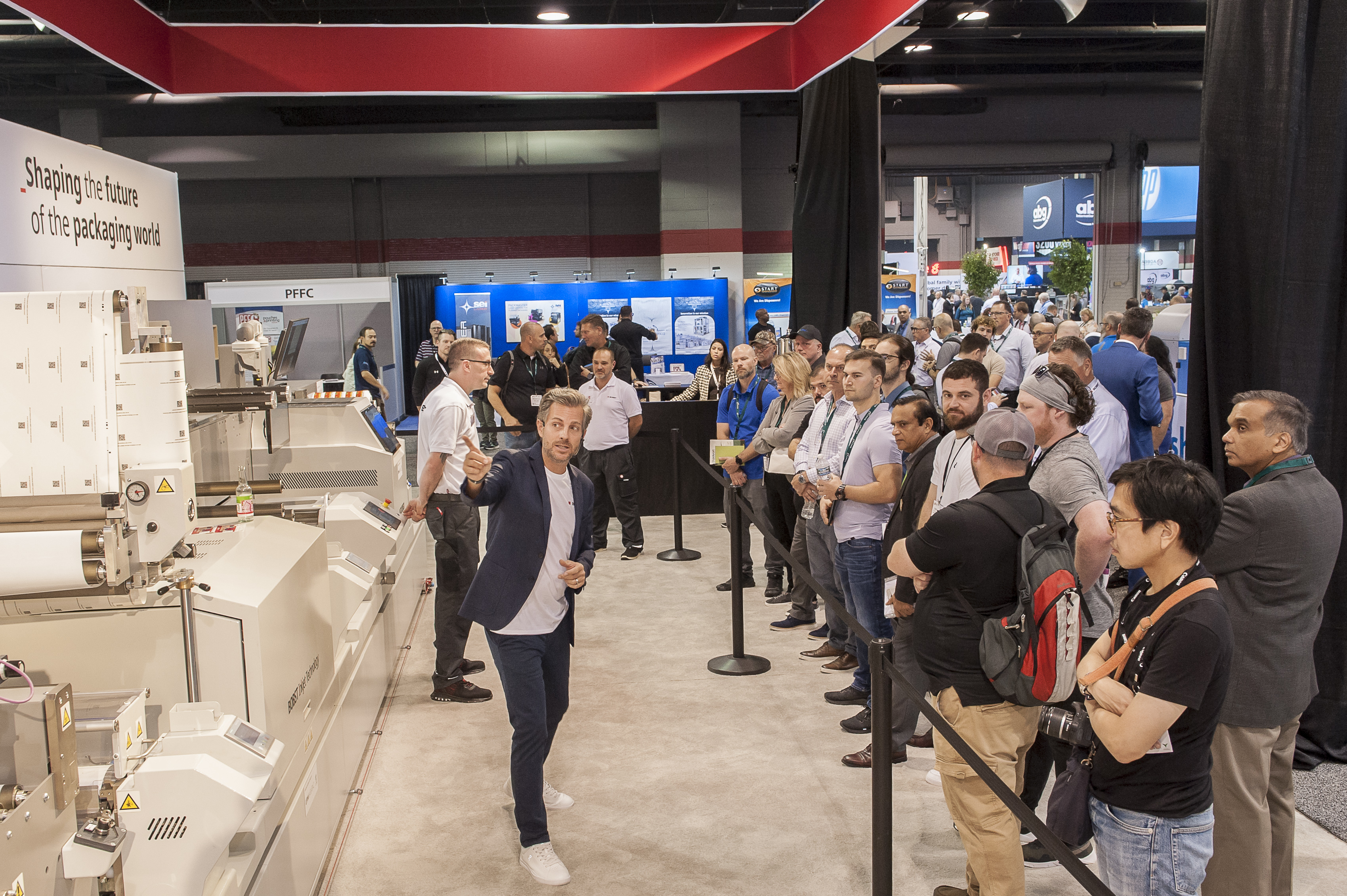
‘We now have a fully closed loop and automated setup, so the output of the press is no longer impacted by the skill of the operator,’ explains Patrick Graber, marketing director narrow-mid web printing & converting at Bobst.
‘And with our oneECG extended gamut system, we are digitalizing color, so our conventional and digital equipment use the same color data.’
Graber also previewed Bobst’s forthcoming Digital Front End (DFE) 3.0, which will be commercially available in early 2025. This Cloud-based system will enable users across a network to access real-time data, resources, and workflow templates. Color management can be centralized and shared as needed, with the web-based interface supporting multiple users across multiple sites.
Other announcements included the release of Thalia UV digital inks, which are Swiss Ordinance-compliant and deliver a wider color gamut, and a certified substrate database. Graber also highlighted Bobst’s close cooperation with Avery Dennison, developing an inline silicone coating module for Avery’s LinrSave linerless system.
“Nilpeter demonstrated ramping press speed up and down, and even deliberately putting the press out of registration, to demonstrate how effective the vision system is in automatically bringing the press back into register”
Gallus CEO Dario Urbinati gave an update on the Gallus One digital press shown on the company’s stand. The first Gallus One in the US went to PrintFlex Graphics (which interestingly further invested in a Labelmaster flexo press). At the show, NextGen Label Group announced the purchase of the first hybrid Gallus One in the US, a 15-color machine (8x flexo and 7x digital colors) built on the new, wider 17in/430mm Gallus One platform. The press will include the ability to cold foil, spot varnish and add tactile lamination.
The 13in and 17in web widths for the Gallus One now match the modular Labelmaster platform, and under Gallus’ newly announced ‘System to Compose,’ any Labelmaster flexo, decoration or converting unit can be added to the Gallus One. Conversely, a Gallus One can be retrofitted into an existing Labelmaster press to turn it into a hybrid press.
“Gallus has now developed a method of modifying the surface of an inkjet drop to change the way light is reflected, creating a matte look. This, we believe will be a game changer for UV inkjet”
Additionally, Gallus has added orange and violet to the Gallus One’s print engine to further extend the color gamut.
Gallus One is now fully integrated into Heidelberg’s Prinect Cloud-based workflow automation system.
Another key announcement was the launch of Gallus MatteJet, which allows UV inkjet to play in the wine and spirits sector. Without a matte overcoat, UV inkjet inks have a glossy finish, which is not generally welcomed in the more traditional wine and spirits market.
Gallus has now developed a method of modifying the surface of an inkjet drop to change the way light is reflected, creating a matte look.
‘This we believe will be a game changer for UV inkjet,’ says Urbinati. ‘It works with open, structured, non-coated papers. It is the same ink and the same machine and the same dots. We are simply modifying that dot. And this is available at the touch of a button. Up to now, you could only achieve this matte effect with a varnish, but that impacts the paper itself.’
HP Indigo showed for the first time in North America its 200k mid-web press. Although designed primarily for unsupported film materials like flexible packaging and shrink sleeves, the 200k press is now fitted with a slitter that allows printing of self-adhesive labels. Slit rolls can be converted on standard 13in/330mm offline finishing machines.
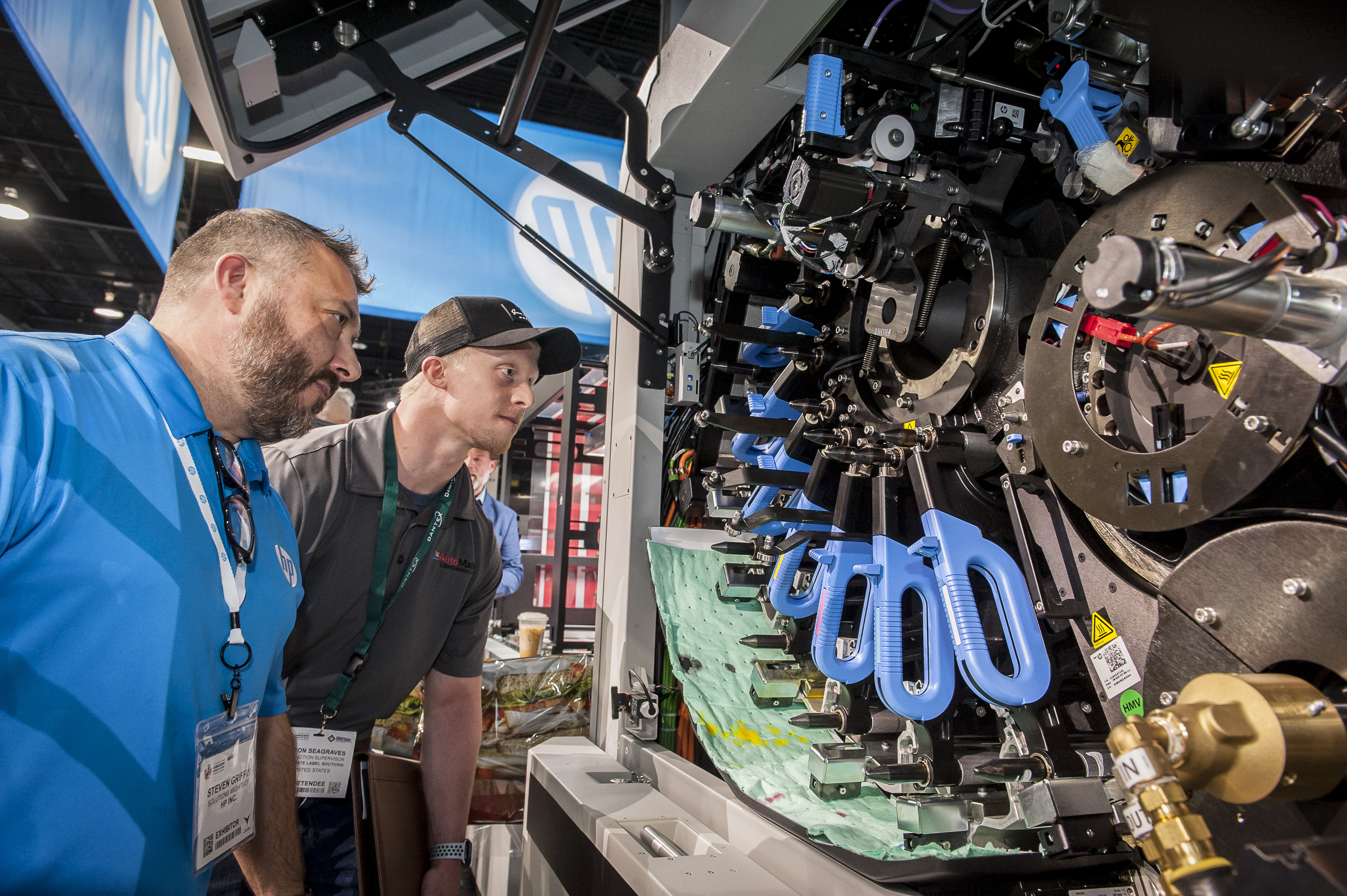
‘This time, with the 200k, we opted to show the labels option so customers can move very quickly – in less than an hour - from labels printing into flexible packaging and vice versa,’ explains Noam Zilberstein, vice president and general manager, HP Indigo. ‘We already have labels customers who are moving into flexible packaging for the first time, and the other way around. For us, while the labels market is growing at 10 percent, the digital flexible packaging market is growing at 20 percent.’
Also on stand was a 6k press, where HP Indigo was demonstrating its Intelligent Automation (IA) workflow launched at drupa, which ultimately aims to connect everything from on-press workflow to live production data and to the final customer via PrintOS.
Durst Group marked the North American launch of its KJet hybrid press, integrating a fully loaded Tau RSCi 1200 x 1200 DPI print engine with components from Omet’s KFlex dual servo flexo press platform.
Steve Lynn, director labels and packaging at Durst North America, stressed that this is very much a Durst-led project. It is now part of Durst’s product catalog and will be sold and supported by the company globally. The configuration of the KJet can be tailored to the specific requirements of each customer.
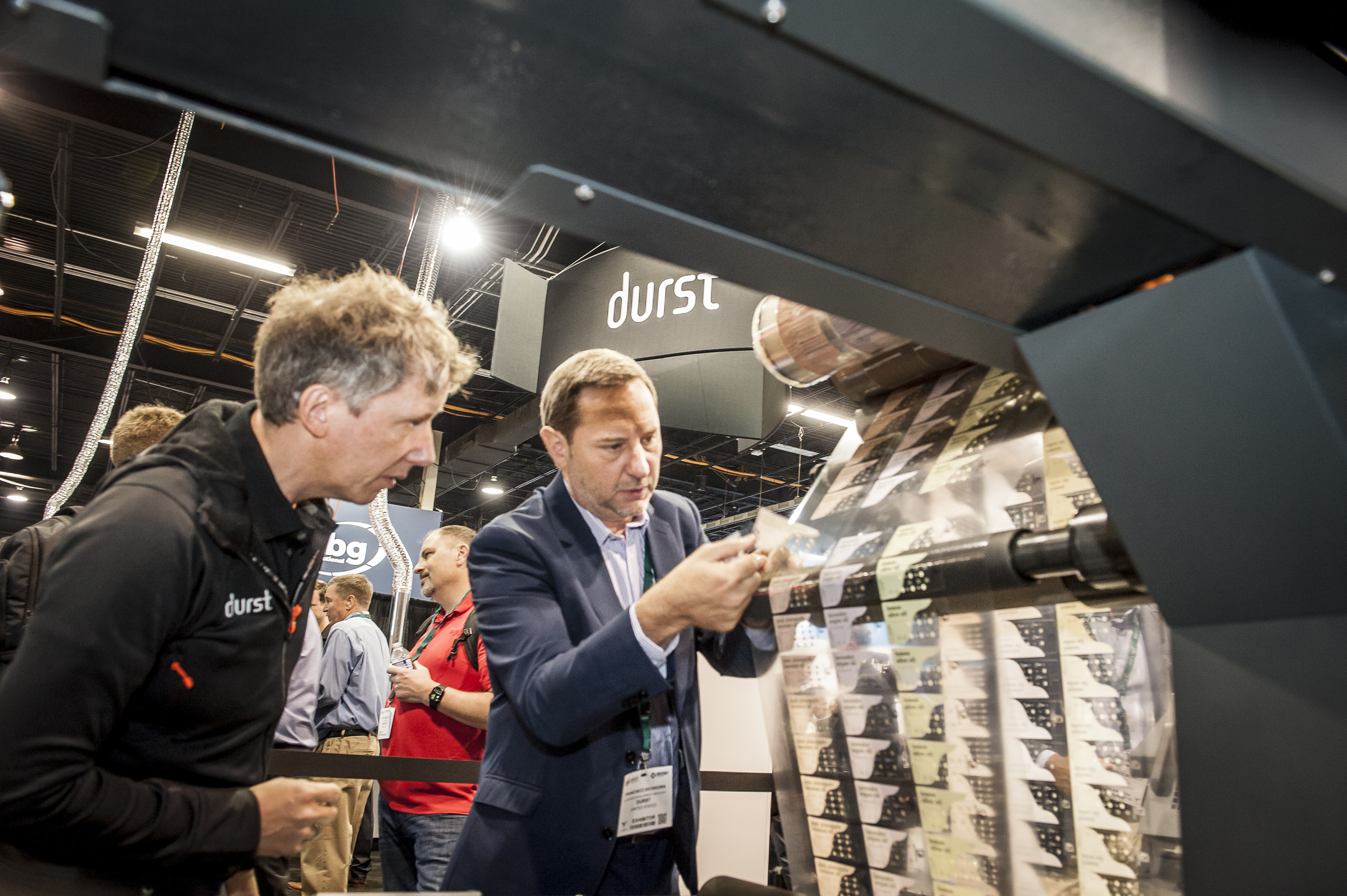
Also on the stand was a Tau RSCi press incorporating Durst’s new Hawk AI quality control system, which automates print quality adjustments in real-time at full press speed, resulting in significantly reduced waste and overall improved print quality.
‘The Durst Hawk AI is both an inspection system and a correction system, correcting print issues without any setup needed and without any operator intervention,’ says Lynn.
Dantex showed its latest PicoJet UV inkjet press, which uses the company’s new Digital Resolution System (DRS) technology to achieve 1700-2,400 DPI (at eight gray levels) at a speed of 246ft/min (75m/min). Dot size is variable between 2.5 and 21pl.
Dantex says it exclusively owns the proprietary DRS technology, which was developed in partnership with Ricoh, which supplies the inkjet heads.
At the same time, Dantex says it has increased the color gamut of the press to hit 99 percent of Pantone shades at a DeltaE of 3, and 97.5 percent at a DeltaE of 2. The press’ SuperWhite mode offers inkjet White at an opacity of 92 percent in a single pass.
New for the PicoJet is an inline semi-rotary die-cut unit, along with the SuperTactile digital embellishment module.
Dantex also used Labelexpo Americas to announce a strategic partnership with Global Graphics, a Hybrid Software company. The collaboration will see Global Graphics’ SmartDFE technology integrated into Dantex’s PicoJet presses. SmartDFE components include job creation, prepress workflow and color management. The PicoJet already uses printhead drive electronics from Meteor Inkjet, another Hybrid Software company.
Canon promoted its prototype water-based label press, the LabelStream LS2000.
The LS2000 prints at 131ft/min (40m/min) in CMYK + double white at 2400 x 1200 DPI with ink recirculation to help eliminate nozzle clogging and extend printhead life. Food-safe polymer water-based inks were developed by Canon specifically for these printheads. Canon says the inks contain highly saturated pigments, which produce a wide color gamut.
The press has a unique configuration. The web is first printed with a primer, which aids ink adherence, followed by a double white, after which the web is dried on an extended web path, followed by CMYK printing and drying.
Printhead maintenance, along with color measurement and adjustment, is fully automated. Qualified substrates for the LabelStream LS2000 currently include coated, synthetic and textured papers and even some heat-sensitive films.
The LabelStream LS2000 will be commercially available in 2025.
Also on the Canon stand was the Colorado M-series large format printer, along with LX benchtop printers for asset management, retail and barcode printing applications.
And for the first time since its acquisition by Canon, Edale had a significant presence demonstrating in-line flexo folding carton samples.
China-based Hontec was present with its new Flexicon flexo press, developed together with international press design consultant Ibrahim Mesinovic.
The Flexicon press has a vertically adjustable (as well as front-to-back adjustable) plate cylinder to allow for different material thicknesses. A 21.5in chill drum allows a wide range of temperature-sensitive materials to be handled. A removable idler impression roller means the chill drum does not have to be cleaned of ink residues between jobs.
The FlexiCon press operates at speeds up to 150m/min (492ft/min) with Industry 4.0 connectivity.
Mesinovic is now working with Hontec CEO Leo Zhang to develop a new generation of flexo press technology. An 850mm-wide mid-web press is expected to be launched at Labelexpo Europe in Barcelona next year.
Digital print bars and heads
Press-wide mono digital print bars are proving a major area for development, adding enormous versatility to not just flexo presses but to finishing/converting systems and even to laminators. Applications can range from variable data - typically 2D and QR codes – to digital embellishments with tactile effects.
JetFX promoted digital embellishments on several machines throughout the show, with its new Solo Fusion 13in/330mm-wide print bar and Solo FlexPack 30in wide printbar specially formulated for eBeam and UV inkjet coating for full FDA compliance. A Solo Flexpack was incorporated into a Gonderflex laminator, allowing tactile embellishment effects to be added to flexible packaging. Both GM and Prati also incorporated Solo Fusion units onto their converting equipment.
Digital Print, Inc introduced its M7 13in-wide digital print bar, operating at up to 800ft/min (243m/min) at 600 DPI for applications including variable barcodes, text and graphics.
The system can be scaled up to print widths of 26in/670mm and can be configured to print duplex. It also comes in a double bar configuration that can run twice the speed and resolution of a standard single bar system.
Fujifilm’s specialist inkjet division demonstrated its 46kUV print bar operating at speeds up to 500ft/min (152m/min) at 1,200 x 600 DPI. The 46kUV uses the Samba printhead and is available in 13, 17, and 20in print widths. The company also displayed the DE1024 digital embellishment system, which is able to add gloss or tactile effects to existing analog or digital print production.
General Inkjet Technology showed its modular Label Smart 330HD digital press printing at 1,200 x 1,200 DPI resolution with the capability to scale up to nine color channels printing at speeds up to 230ft/min (70m/min). Its modular design allows for several optional equipment configurations, including coating, printing, varnishing, foil-stamping and cold-stamping.
Domino showed its K600i print bar and K300 module integrated on a Mark Andy Pro Series flexo press, with Domino-owned Lake Image Systems providing inline vision inspection.
The company also demonstrated its new K300 VDP unit printing at 410 fpm (125m/min) at 600 DPI, or 820 fpm (250m/min) at 300 DPI. Each K300 module is 2.1in (54.1mm) wide with one print station, or 4.26in (108.2mm) with two print stations.
Direct to shape
Direct-to-shape labeling is a fast-growing sector. While it will not threaten the substrate-based label industry any time soon, it will certainly continue to develop a niche in the short run/personalized fast-moving commercial goods product sector.
Velox demonstrated its IDS-NC 500 machine for digital printing directly on necked beverage cans, running at up to 500 cans a minute. Velox says its technology of proprietary inks and system architecture features a wide color gamut, photorealistic imagery, opaque selective white, matte and gloss finish, smooth gradients and end-to-end decoration with no seam or overlap.
Hinterkopf was meanwhile testing the market with a dummy version of its D120 direct-to-shape system, also for on-demand printing of cans.
Heidelberg promotes sheetfed IML and wet glue
For the first time at a Labelexpo show, Heidelberg was promoting its sheetfed cut-and-stack and IML print and converting equipment alongside Gallus roll-fed equipment.
Clarence Penge, EVP for sales, product management, and marketing for Heidelberg US, introduced the next generation Speedmaster XL106, which prints at 21,000 sheets per hour on a 41 x 29in sheet size – ‘an in-mold label and wet glue label powerhouse.’
Penge said Heidelberg US is seeing consistent annual growth in IML volumes and has adapted the press for the lighter grammages specific to that market.
Recently, Moquin Press, one of the West Coast’s leading label and packaging providers, set a new world record, producing 452,755 net sellable sheets on its Peak Performance Speedmaster XL106 in 24 hours. Moquin’s press is the first from Heidelberg specially designed for label production – featuring modifications like special sheet travel adjustments in the units and delivery and the new fourth-generation CutStar, all optimized for high-speed production of thin materials.
More sheetfed label converters are using extended color gamut inks – a well-established technology in the offset industry – saving five to 10 minutes in washup time. ‘And with digital now also offering ECG, it is becoming more accepted by brands. We are using our Prinect software to maximize the number of colors you can match to delta 2.0.’
Penge also listed developments on the finishing side, including the Kawahara blanking system for in-mold labels and increasingly automated Polar wet glue label equipment. ‘The latest Polar SC21 produces 3,000 bundles an hour, and as a bundle could be 50 or 100 labels, that equates to 1.5 -3m labels an hour, and in a very compact footprint.’
Stay up to date
Subscribe to the free Label News newsletter and receive the latest content every week. We'll never share your email address.


